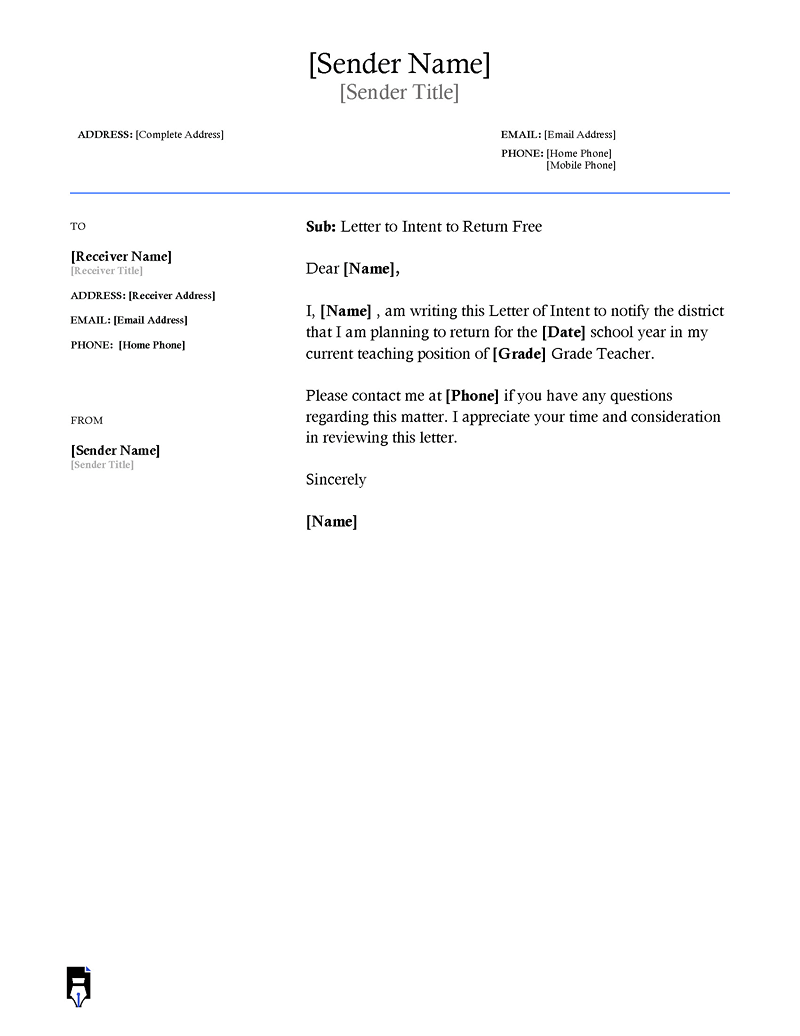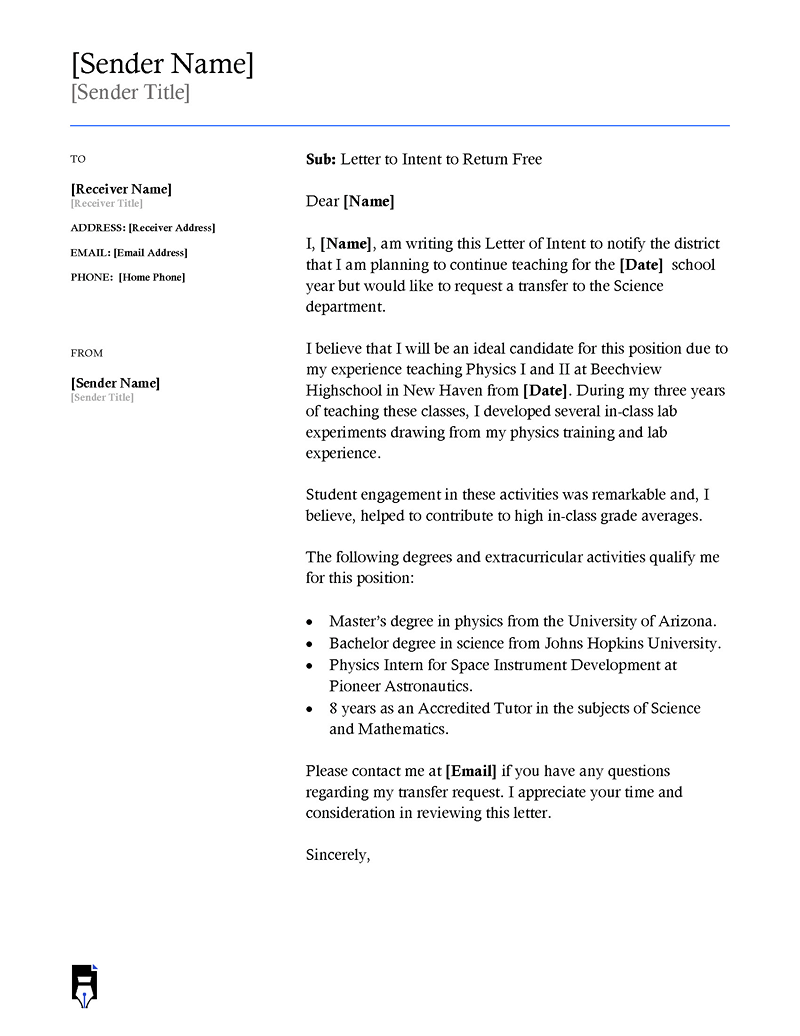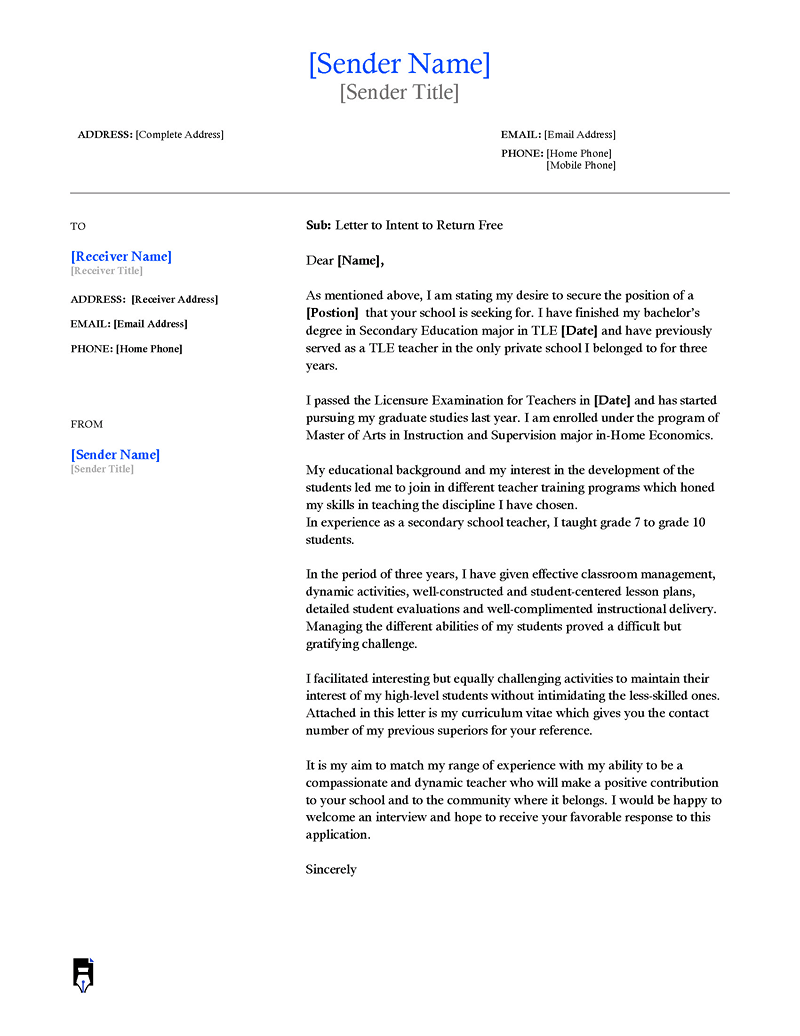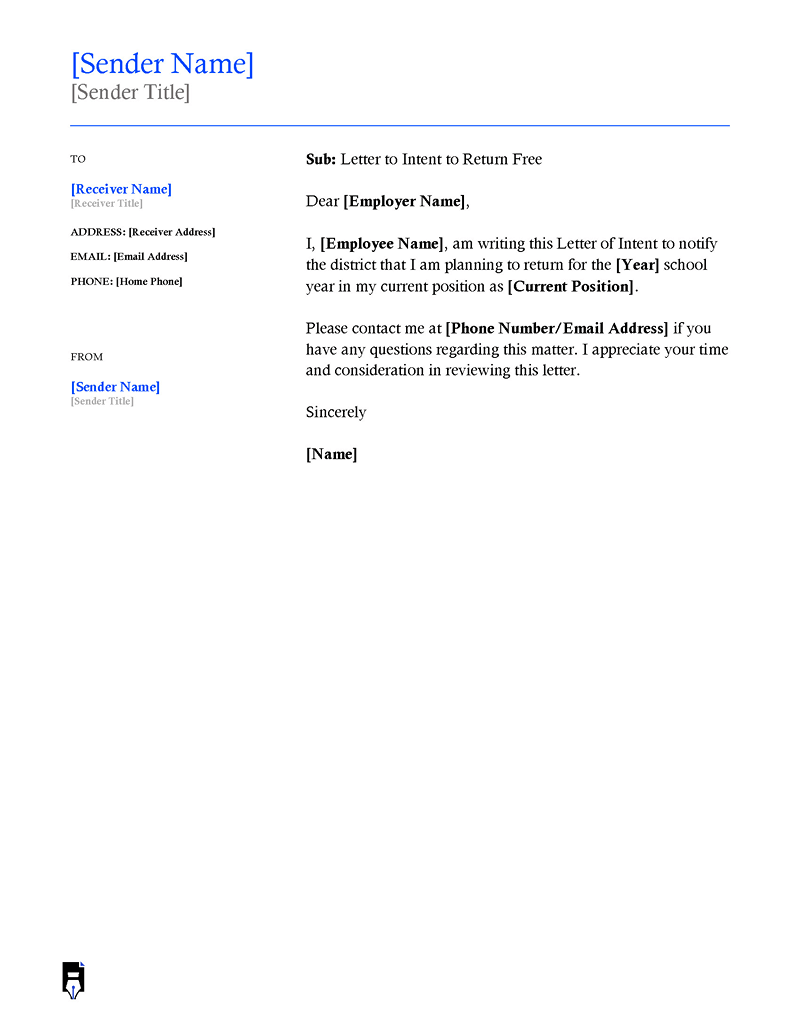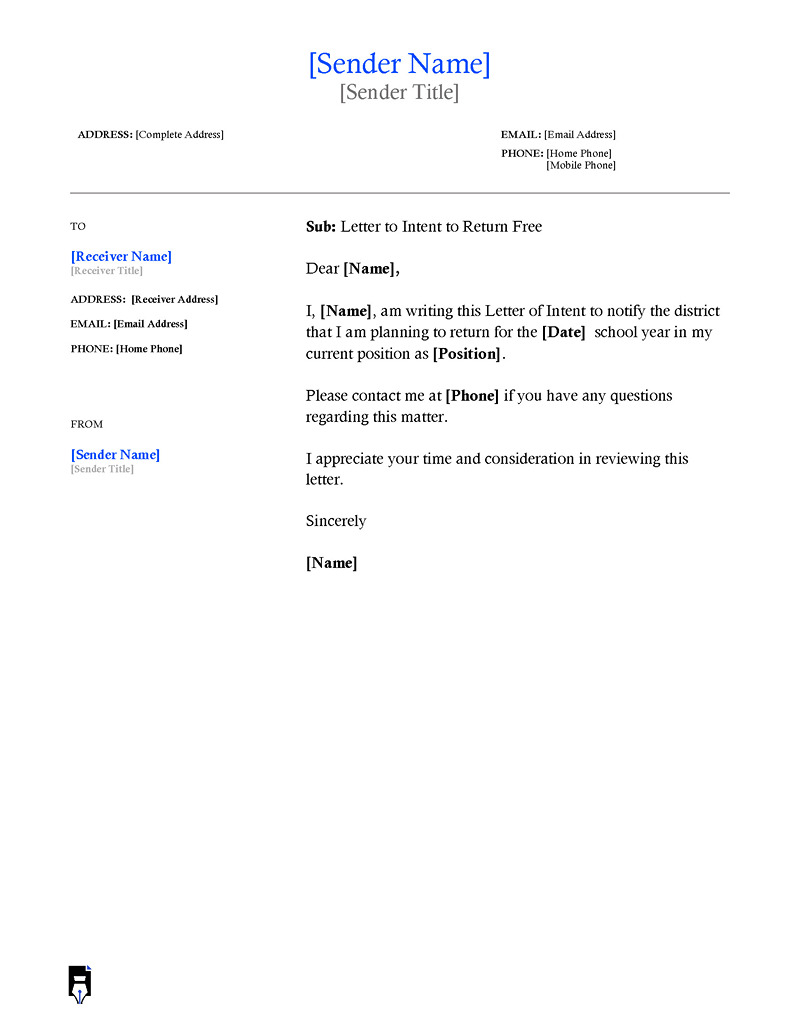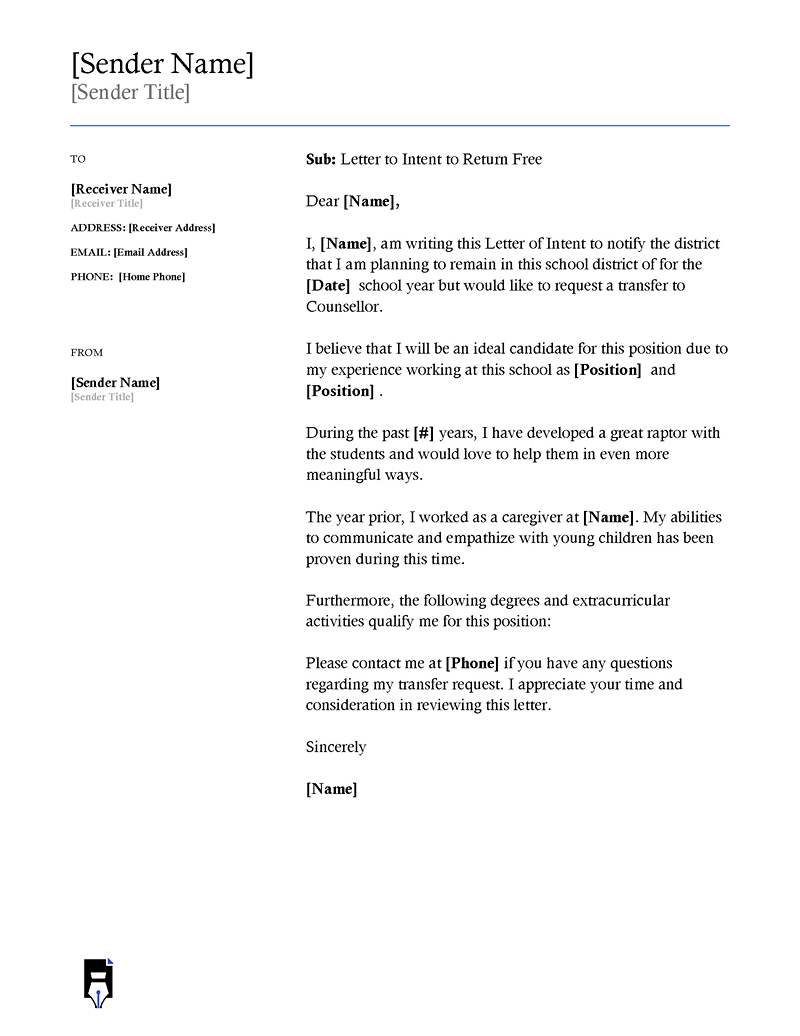Employment in the education sector is a very formalized process requiring constant supervision of staff. This formality extends to teachers in both elementary and secondary schools. As a teacher, a letter of intent is a formality you must fulfill in compliance with education laws. It serves various purposes but generally informs the organization that you intend to start working at the school or continue working there.
Usually, it is used at the end of a school year. The letter must express the reasons, which often affects its format. You can use a letter of intent when applying for a new teaching job, seeking a transfer within the same school or classes, or expressing an intention to return to teaching at a school. It is usually written as a reply to a notice issued by the school. Since it is in response to a notice, you or the school can cancel it because it is not a binding agreement.
This article discusses what a letter of intent is, how to write one, and provides a template and a sample letter. Further, it gives tips on how to write a comprehensive letter.
Letter of Intent Templates
While writing a letter of intent may seem easy, you may find it hard to start from scratch every time you want to write one. You should use a pre-made template to make it easy to prepare your letter. The template provides a guideline on what your letter of intent to return to school position should include. Furthermore, they are editable and can be used multiple times.
Letter of Intent to Return to School
The letter of intent allows you to communicate your interest in continuing to teach at your school. The Education Code stipulates that a school’s probationary and permanent employees must confirm their intent to continue their duties in the next school year. This confirmation is usually done before summer vacation through a letter of intent in June. Non-teaching employees like coaches and librarians may also use this letter to confirm their availability for the next school year.
The letter of intent may communicate either of the three situations. First, when you intend to resume duties in the next school year. Second, when you want to continue teaching but want to be transferred to another position, subject or department. Third, when you are applying for a new job. When applying for a new place or seeking to be transferred, you should include your relevant experience and qualifications in the letter.
These letters are mandatory; if you fail to send one to the school, it is assumed that you do not want to perform your duties in the next school year. As a job seeker, this letter will act as a cover letter describing your skills, qualifications, and experiences that make you suitable for the teaching position.
Responsibilities of a School Teacher
School teachers are responsible for the educational needs of students. When dispensing their duties, they are expected to adhere to the education code and other rules set by law. In addition, teachers must attain a bachelor’s degree as a minimum academic requirement.
Besides being specialized in your teaching area, you may be required to teach other subjects like physical education or literature. Further, at the beginning of each year, you may be required to restructure your lesson plans to cater to your student’s needs and to achieve the learning outcomes set in the curriculum.
Some of the responsibilities of school teachers include the following:
- Preparing lesson plans and conducting lessons
- Monitoring students and their participation during classes
- Preparing assessments and supervising examinations
- Marking and grading student examinations
- Designing and implementing subject curriculums
- Performing administrative tasks like setting up lesson equipment and printing learning materials
How to Write a Letter of Intent: 6 Easy Steps
You can write different letters of intent depending on the reasons. While the format of this letter is standard, you must state the reasons for writing the letter.
The following steps can guide you in writing your letter of intent to return to school:
Header
The first section of the letter is for identification and verification purposes. It would be best to begin by providing your contact information and correctly addressing the recipient. Where you have sufficient information, address the recipient directly by mentioning their name. For example, the recipient could be the city or the Department of Education office.
Other places also have a human resources office that serves this purpose. For example, elementary school teachers often address this letter to the superintendent or human resource officer. If you cannot identify the recipient, it is advisable to address the department directly.
The address is written in the top left corner of the letter. The salutation should be the recipient’s name, or you can refer to them as “sir/madam” where you do not know their names.
For example:
Reyes Smith,
154 Woodvale Grove,
15763 Orlando, FL
May 15, 2018
Department of Teacher Education,
Woodvale Secondary School,
14663 Woodvale Avenue,
16678 Orlando, FL
Dear Ms. Bloomington,
Specify the purpose of writing the letter
Your objective for writing the letter should be one of the first things you write. It allows the recipient to assess how to handle your request if any. For instance, if you wish to be transferred to another class or department, you should state it in the first paragraph and expound on it in the next paragraph.
For example:
I, Reyes Smith, am writing this letter to confirm that I intend to continue teaching in the upcoming 2018-2019 school year. Therefore, I am requesting to be transferred to the English Department.
Share your experience
Once you specify your reason for writing the letter, you should mention the relevant experience that makes you fit for the position you seek. You may briefly mention the positions you have held and your level of education.
For example:
I have served as a teacher of English for seven years, with practice in grades 8 to 11. I have a Master’s degree in the English language, and during my studies, I practiced as an assistant to my professor. As a teacher, I prepared lesson plans and assessments and had an above-average pass rate for my students.
Highlight your qualification/education
Once you describe your experience, you should highlight your qualification. Where you can, state various licenses, degrees, and certificates you have obtained. Ensure you only state the relevant qualifications.
For example:
–Master in English education
–Bachelor of Arts in English education
–Seven years of experience as a secondary school English teacher.
–TEFL certified
Show them what you have got
After listing your experience and certifications, you may list particular achievements to increase the chances of your request being approved. For example, you may state unique skills or talents that make you a better teacher. It may include an activity like coaching a champion spelling bee team.
For example:
During my tenure as a teacher at Walkwood High School, I coached their spelling bee team through the district and to the National level, where we took the first position. I have also taken classes for children with special needs.
Add a call to action
A call to action is persuasion directed at the recipient to contact you. As such, it may not be needed if your letter of intent confirms that you plan to continue working at the school for the next academic year.
It may appear as follows:
Should you require further clarification, do not hesitate to get in touch with me at (555) 462642. I hope to hear from you soon. Thank you for your time and consideration.
Closing
You should conclude your letter with a formal ending such as “sincerely” or “yours faithfully.” You are encouraged to use formal closing statements as your letter is an official correspondence. After using the proper salutation, you should sign the letter and type your name.
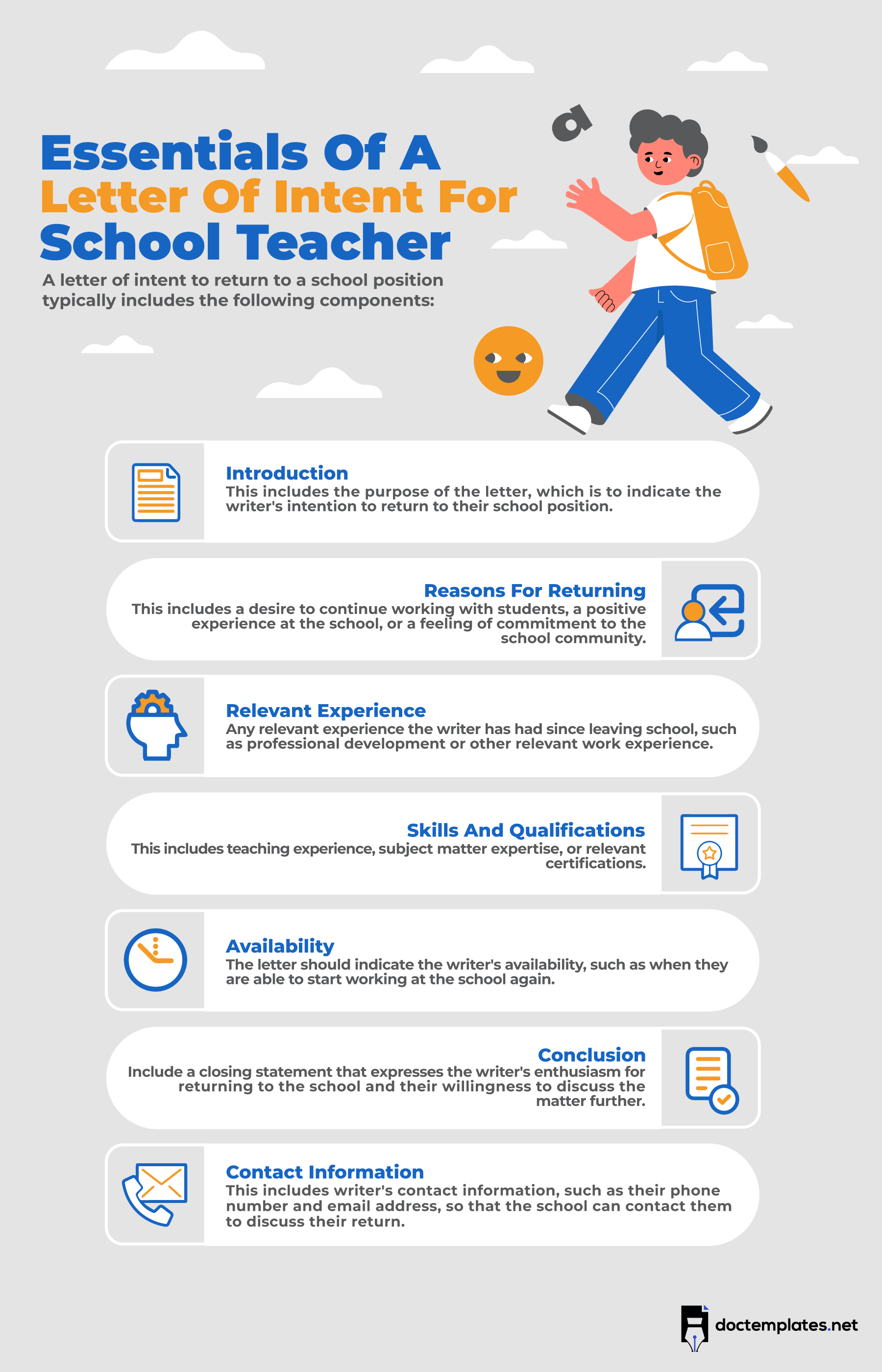
Letter of Intent to Return to School Template
[Sender’s name]
[Mailing address]
[City, state, zip code]
[Date]
[Department, school]
[Address]
[City, state, zip code]
Dear _____________ [Recipient’s name],
I, _______________ [sender’s name], write this letter to notify the _________________ [district] that I plan to continue teaching at ___________________ [name of school] for the _______________ [state the academic year], but I would like to be transferred to the _____________ [name of alternate department].
I believe that I am fit for this position because I have experience in _______________ [ list areas of expertise, including the number of years and institutions]. In addition, during my tenure as ________________ [state relevant position], I ________________________ [state specific notable achievements].
In addition, the following academic certificates and activities contribute to my expertise as a ____________________ [the name of the department you want to be transferred to]: [outline bachelor’s and master’s degrees and other certifications in bullet point]
Please get in touch with me at ___________________ [contact details] if you require further information. Thank you for reviewing my letter.
Sincerely,
______________ [Signature]
_______________ [Sender’s name]
Letter of Intent to Return to School Sample
Ben Donaldson,
1011 Brookhurst Rd
46369 Beverly Hills, CA
555-5328479
May 21, 2017
Department of Education, Hillpark Secondary School,
6139, Denvile Dr
6424 Wilmington, CA
Dear Mr. Smith
I, Ben Donaldson, am writing this letter to confirm that I want to continue teaching the 10th Grade at Hillpark Secondary School in the upcoming 2017-2018 school year. I have enjoyed taking the 10th-grade class through the previous year and believe that my students have gained the skills and knowledge stipulated in the curriculum. In addition, I am confident that my eight years of experience in class management and school administration make me a suitable teacher for the next 10th-grade science class. I also have a successful track record in teaching and relating well with students.
Should you have any questions concerning my position, please reach me at 555-5328479. I appreciate you for taking the time to review this letter.
Sincerely,
Ben Donaldson.
Best Practices to Consider
When writing your letter, you should ensure you tailor it to fit your needs, be it a request for a transfer or an application for a new position.
You should consider the following practices to help you write a comprehensive letter:
Be concise and state facts
Your letter should state only the most relevant information. You should avoid using flamboyant words and providing more than necessary information. You should only state facts and give essential figures where it is needed.
Length of the letter
The preferred length for a letter of intent is one to two pages. However, you should use a minimum of 400 and a maximum of 800 words. This length includes your references and contact information.
Proofread and edit your letter
Well-written letters should be free of grammatical and spelling errors. Therefore, after you finish writing your letter, you should proofread it and remove any mistakes you identify. You can also request a friend to read it and identify the errors you may have failed to see.
Final Thoughts
A letter of intent acts like a cover letter, primarily if it is written as a request for a transfer or an application; as such, it should be well drafted. It promotes confidence in the recipient that you intend to continue working with the school/organization. It is also a sign of professionalism as it helps to streamline the process of employing teachers.
When writing your letter, identify yourself as the sender or writer and specify your intent in the first paragraph. This will allow the recipient to understand why you are writing the letter. Your letter should contain three to four paragraphs outlining your experiences and qualifications and a conclusion providing contact information.
